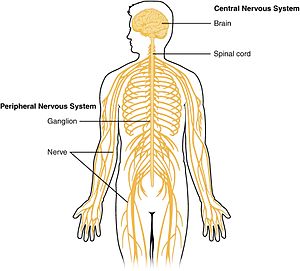Insect central nervous system
| Central Nervous System | |
|---|---|

Schematic diagram showing the central nervous system in yellow, peripheral in orange
|
|
| Details | |
| Lymph | 224 |
| Identifiers | |
| Latin | Systema nervosum centrale pars centralis systematis nervosi |
| MeSH | 264 |
| Code | WM1 |
| TA | A14.1.00.001 |
| FMA | 55675 |
|
Anatomical terminology
[]
|
|
The central nervous system (CNS) is the part of the nervous system consisting of the brain and spinal cord. The central nervous system is so named because it integrates information it receives from, and coordinates and influences the activity of all parts of the bodies of bilaterally symmetric animals—that is, all multicellular animals except sponges and radially symmetric animals such as jellyfish—and it contains the majority of the nervous system. Many consider the retina and the optic nerve (2nd cranial nerve), as well as the olfactory nerves (1st) and olfactory epithelium as parts of the CNS, synapsing directly on brain tissue without intermediate ganglia. Following this classification the olfactory epithelium is the only central nervous tissue in direct contact with the environment, which opens up for therapeutic treatments. The CNS is contained within the dorsal body cavity, with the brain housed in the cranial cavity and the spinal cord in the spinal canal. In vertebrates, the brain is protected by the skull, while the spinal cord is protected by the vertebrae, both -brain and spinal cord- enclosed in the meninges.
The central nervous system consists of the two major structures: the brain and spinal cord. The brain is encased in the skull, and protected by the cranium. The spinal cord is continuous with the brain and lies caudally to the brain, and is protected by the vertebrae. The spinal cord reaches from the base of the skull, continues through or starting below the foramen magnum, and terminates roughly level with the first or second lumbar vertebra, occupying the upper sections of the vertebral canal.
...
Wikipedia
